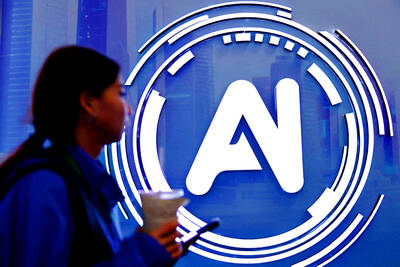Walsin Technology Corp (華新科技) reported its first quarterly loss in about eight years due to sluggish demand for passive components used in communications and electronics amid a slowing economy.
The passive component maker posted losses of NT$490 million (US$16.08 million), or a loss of NT$1 per share, during the final quarter of last year, it said in a financial statement to the Taiwan Stock Exchange on Friday.
That compares with a net profit of NT$947 million in the same period of 2021 and net profit of NT$510 million in the third quarter of last year.

Photo: Chang Hui-wen, Taipei Times
Gross margin was 12.65 percent last quarter, falling from 21.4 percent a year earlier and 14.23 percent in the previous quarter.
Last quarter’s losses contributed to a 79 percent year-on-year decline in net profit to NT$1.65 billion last year, compared with NT$7.93 billion in 2021, the company’s financial statements showed.
Last year’s net profit was the lowest since 2015.
Revenue contracted 16.5 percent to NT$35.33 billion last year, compared with NT$42.09 billion in 2021, as softening consumer spending amid surging inflation and a slowing global economy took a toll on demand for mobile phones, computers and consumer electronics.
Walsin generated the bulk of its revenue from those products.
The company has relatively smaller exposure to the automotive sector, which is one of the few areas that are still growing, despite a broad downtrend in the industry.
Robust demand for passive components used in autos, particularly in Tesla electric vehicles, helped boost the book-to-bill ratio for multilayer ceramic capacitors (MLCCs) worldwide to 0.79 this month, market researcher TrendForce Corp (集邦科技) said in a report earlier this month.
Walsin lagged behind rivals in tapping into the automotive sector, but the company is expected to expand its MLCC capacity to between 2.5 billion and 3 billion a month this year, compared with a monthly capacity of between 1.5 billion and 2 billion, TrendForce said.
The world’s major passive component makers are expected to invest heavily on automotive MLCC capacity expansions this year to vie for a bigger market share, the Taipei-based researcher said.
The shift comes as demand for consumer electronics has soured since the third quarter of last year, it said.
Yageo Corp (國巨), the world’s No. 3 MLCC supplier, is also expected to add 2 billion to 3 billion to its capacity this year, following in the footsteps of its global peers, TrendForce said.
With price competition accelerating, Trendforce expects Japanese suppliers to exit the low-end automotive MLCC market, while Taiwanese and Chinese MLCC makers compete for bigger market shares.
Yageo is expected to see its share of the automotive MLCC market expand to 14 percent this year from 9 percent last year, TrendForce said.
Murata Manufacturing Co, the world’s top massive component maker, is likely to see its share drop to 41 percent from 44 percent last year, it said.

CHIP RACE: Three years of overbroad export controls drove foreign competitors to pursue their own AI chips, and ‘cost US taxpayers billions of dollars,’ Nvidia said China has figured out the US strategy for allowing it to buy Nvidia Corp’s H200s and is rejecting the artificial intelligence (AI) chip in favor of domestically developed semiconductors, White House AI adviser David Sacks said, citing news reports. US President Donald Trump on Monday said that he would allow shipments of Nvidia’s H200 chips to China, part of an administration effort backed by Sacks to challenge Chinese tech champions such as Huawei Technologies Co (華為) by bringing US competition to their home market. On Friday, Sacks signaled that he was uncertain about whether that approach would work. “They’re rejecting our chips,” Sacks

NATIONAL SECURITY: Intel’s testing of ACM tools despite US government control ‘highlights egregious gaps in US technology protection policies,’ a former official said Chipmaker Intel Corp has tested chipmaking tools this year from a toolmaker with deep roots in China and two overseas units that were targeted by US sanctions, according to two sources with direct knowledge of the matter. Intel, which fended off calls for its CEO’s resignation from US President Donald Trump in August over his alleged ties to China, got the tools from ACM Research Inc, a Fremont, California-based producer of chipmaking equipment. Two of ACM’s units, based in Shanghai and South Korea, were among a number of firms barred last year from receiving US technology over claims they have

It is challenging to build infrastructure in much of Europe. Constrained budgets and polarized politics tend to undermine long-term projects, forcing officials to react to emergencies rather than plan for the future. Not in Austria. Today, the country is to officially open its Koralmbahn tunnel, the 5.9 billion euro (US$6.9 billion) centerpiece of a groundbreaking new railway that will eventually run from Poland’s Baltic coast to the Adriatic Sea, transforming travel within Austria and positioning the Alpine nation at the forefront of logistics in Europe. “It is Austria’s biggest socio-economic experiment in over a century,” said Eric Kirschner, an economist at Graz-based Joanneum

BUBBLE? Only a handful of companies are seeing rapid revenue growth and higher valuations, and it is not enough to call the AI trend a transformation, an analyst said Artificial intelligence (AI) is entering a more challenging phase next year as companies move beyond experimentation and begin demanding clear financial returns from a technology that has delivered big gains to only a small group of early adopters, PricewaterhouseCoopers (PwC) Taiwan said yesterday. Most organizations have been able to justify AI investments through cost recovery or modest efficiency gains, but few have achieved meaningful revenue growth or long-term competitive advantage, the consultancy said in its 2026 AI Business Predictions report. This growing performance gap is forcing executives to reconsider how AI is deployed across their organizations, it said. “Many companies